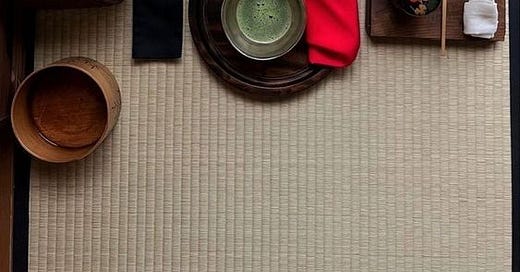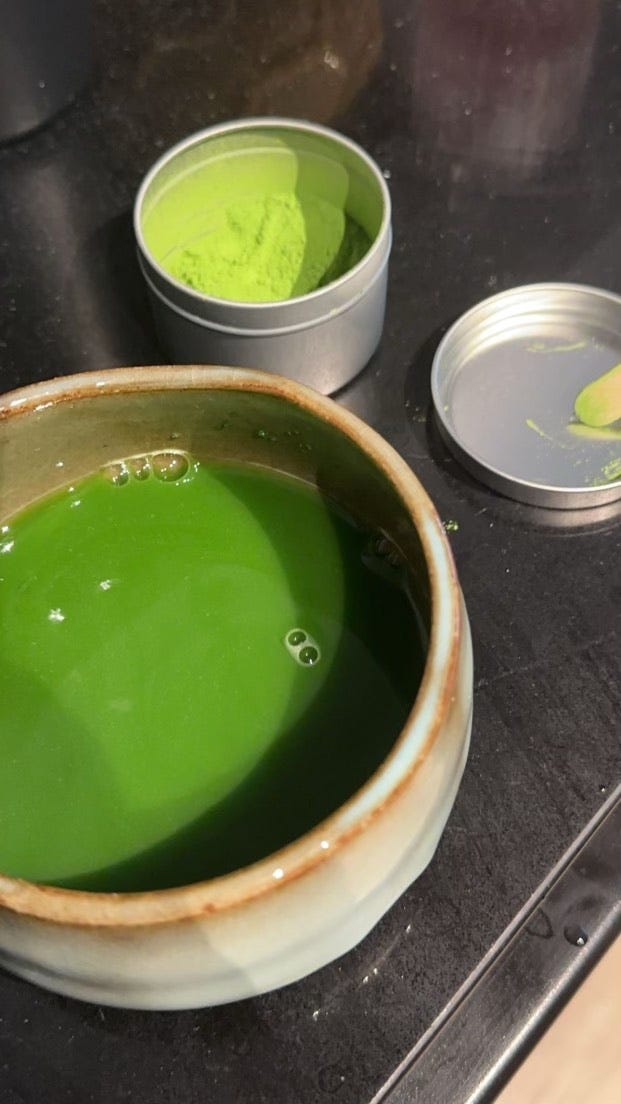Welcome back to Tea Tidbits! I am so excited to introduce you all to my favorite tea, matcha. If you are accustomed to matcha then I hope you will learn something new about this incredible tea. When I go on social media, everyone talks about how matcha tastes like grass, even some of my close friends have said this, why is that? Well in my opinion, you just haven’t tried high quality matcha before. That being said, let’s get into it!
Japanese green tea is split up into many sections as you saw if you read my previous post. Matcha falls into Japanese style shaded green tea, it comes from Tencha leaves.
What is Tencha?
Tencha is known as tea leaves that are meant for grinding. Tencha leaves get shaded anywhere from 20-50 days, which makes it the longest shaded tea out of Gyokuro and Kabusecha. Tencha has the highest leaf quality which makes it the only tea eligible to make matcha out of.
How is Tencha processed?
Tencha leaves are fertilized three times in order to make the leaves sweeter and are then shaded for a minimum of 20 days. The shading period is why the best quality matcha’s are such a vibrant green. The leaves are then harvested and within 24 hours, they are steamed and air dried. The leaves then have their veins and stems removed, the flatter leaves are used for the best quality matcha.
You can brew loose leaf Tencha, it will result in a very light cup of tea with a unique flavor and intense sweetness.
(You are probably wondering well how do these leaves turn into matcha, before we get into this let’s talk about some history.)
During the Tang Dynasty in China (7th-10th century) green tea’s were steamed, pulverized then mixed with salt and water and turned into “bricks”. This powdered green tea was then transported around China and during the Song dynasty (10th-13th century) this type of green tea was common. A Japanese buddhist monk by the name Eisai happened to be traveling china and brought this green powder back, he called it the “elixir of the immortals”. He also ended up bringing Camellia Sinensis seeds back to Japan and planting them all around Kyoto. In the 1500s a zen buddhist named Murata Juko created the principles that the Japanese tea ceremonies still run by, harmony, respect, purity, and tranquility.
What tea utensils are needed to make matcha?
Chasen - a bamboo whisk
The legend of the Chasen starts in the middle of the Muromachi period (1336-1573) with the 8th shogun. When tea master Murata Juko requested the best quality Chasen from good friend and son of the shogun, Sosui Irido. Juko moved to Kyoto when the Chasen was completed and Sosui presented this to him at the tea ceremony table. Juko showered Sosui with compliments, and Sosui was so moved by the compliments he dedicated his life to the art of the Chasen. Chasen craftsmen have refined their craft over the years and in Takayama which is the northwest region of Nara. In Takayama there are even 18-25th generation Chasen craftsmen. Unfortunately today most Chasen are mass produced in China and only about 18 Chasen craftsmen exist in Takayama.
(Looking at the Chasen above, they all look different, this is because of their bamboo types)
There are around 1500 total bamboo species in the world with 600 in Japan only. A single stem of bamboo can live 5-10 years while a whole patch can live up to 4 decades. Every 60-120 years bamboo patches will bloom in mass and then die, the patches will then take up to 10 years to recover from their bloom.
Why did tea masters choose bamboo?
Bamboo is known to have antibacterial properties and also be a very sturdy but flexible wood.
What are the different types of bamboo that are shown above?
On the left, the most pale bamboo is white bamboo and it is the best bamboo for Chasen making. In the middle we have black bamboo which is the most heavy duty bamboo and lasts three times longer than white bamboo, but the downside is that this is difficult to carve. Lastly on the right we have soot bamboo which is a rare and unique bamboo that is purposely stained from smoke.
Some of you are probably saying, well why can’t I just use a electric frother?
Using a Chasen is an ode to Japanese culture. Also, the 120 prongs on a Chasen combine the matcha and water perfectly and it wont damage your bowl. The bamboo and the M motion to mix matcha aerates the matcha and creates a strong aroma and smoothness that are not able to be replicated.
How to use a Chasen?
The care of your Chasen is so important in order to make it last and prevent mold.
Soak your Chasen in hot water for a few seconds before every use.
Swirl some warm water in your Chawan or bowl then discard.
Use your bamboo ladle to dump matcha into your sifter and sift it, depending on the strength you want your matcha to be at, 1 spoonfuls/1 oz is standard.
Break up your clumps of matcha with your Chasen to create “koicha” or thick tea paste.
Add around 3-4 oz of water to create “thin tea” or usucha.
Rapidly mix in an M or W motion back and forth to create a froth, do this gently while not touching your Chasen to the bottom of the bowl.
Rinse your Chasen with water only and air dry on a whisk stand in order to prevent mold.
Replace your whisk every 3 months if you use it everyday/almost everyday and if you use it occasionally then replace your Chasen when the tips of the prongs break.
Here is a link to watch a Chasan be made along with some other links to purchase a Chasen and a whisk stand.
Chawan
What is a Chawan?
Chawan is a handle-less bowl that is used in tea ceremonies to whisk matcha in. The Chawan originated in the middle ages and was made up of clay. The decoration on the Chawan will differ based on the season when used in a Japanese tea ceremony.
Chawan’s are usually quite expensive because they are hand made but this one I am linking is so pretty and a decent price, click here for it.
Chashaku - a bamboo ladle
Like the Chasen, the Chashaku also originated in China as it was used to scoop green tea powder. In the 1500s the Chashaku made it to Japan and was used as a medicine spoon then a tea spoon, for matcha.
Here is a link to the one I use!
Okay, Now let’s get into the Matcha part!
How do Tencha leaves get turned into matcha?
The Tencha leaves get ground up with a stone mill. Stone milling matcha is extremely tedious as the stone mill can only create 40 grams of matcha per hour.
If you haven’t noticed, when you buy good quality matcha it clumps up, why is this?
Stone milling or grinding Tencha leaves is done through a funnel between 2 granite stones (shown above) this turns it into a delicate and fine powder. The milling is done slowly enough to ensure that there is friction between the stones to work but not enough friction to oxidize the matcha which can happen if the stone becomes slightly heated. Friction is a state of static electricity that binds to small particles which creates the clumps. You can easily get rid of the matcha clumps by using a stainless steel tea strainer/sifter.
What are the health benefits of matcha?
(matcha has so many health benefits I don't even know where to start!)
Matcha has 10-15% more amino acids present than any Sencha tea and this is because of the shading process. Along with amino acids matcha has strong antioxidants (polyphenols and catechin). All of these different components enhance cognitive function, regulate cardio-metabolic health, and reduce stress while leaving your mood unaffected. Matcha is also great for if you have diabetes because it lowers your blood glucose levels significantly. Matcha also protects against free radicals which come from oxidative stress and inhibits propagation of breast cancer cells through mTOR which signals to regulation components in your ribosomes and affects cell pathways that are responsible for breast cancer. Matcha is also anti inflammatory for your brain. 1 tsp of Matcha has 70 mg of caffeine while espresso has 64 mg, so it can replace your morning coffee.
There are so many matcha’s on the market, how do I know which is good quality?
Well, buying matcha can be very confusing because you see a Starbucks matcha and it’s the palest green color ever. Matcha is split up into 2 categories, ceremonial grade and culinary grade matcha. Ceremonial grade matcha can range from $30-300. Ceremonial grade matcha is absolutely only used for drinking and nothing else. Ceremonial grade matcha uses the highest quality matcha leaves that are produced from the youngest stems and flatest Tencha leaves, this usually creates a thicker texture for your matcha drink and is best drank plain but you can make latte’s with it. Culinary grade matcha is meant for baking and cooking, a lot of big chain brands such as Starbucks use this cheaper matcha for their lattes also. Culinary grade matcha tastes more bitter and grassy. (Personally I only drink ceremonial grade matcha because it tastes better and the texture is better in my opinion).
This is one of my favorite matcha’s and the color it is! (shown above)
What does good quality Matcha taste like?
Different tea farms produce matcha’s that have different tastes, but the overall taste of matcha is rich, umami, and earthy with a sweet finish. I love Ippodo Tea because they have quizzes you can take to find a matcha that is right for you and the taste you want!
Where should I buy my matcha from?
(I am sooo glad you asked, here are a bunch of my personal favorites)
Rocky’s Matcha:
https://www.rockysmatcha.com/products/rockys-matcha-single-cultivar-gokou-matcha-20g (great for beginners)
https://www.rockysmatcha.com/products/rockys-matcha-single-cultivar-asahi-matcha-20g
Ippodo Tea:
https://ippodotea.com/collections/matcha/products/sayaka-no-mukashi (great for beginners)
https://ippodotea.com/collections/matcha/products/ummon-no-mukashi-20g
https://ippodotea.com/collections/matcha/products/kanza
https://ippodotea.com/collections/matcha/products/kuon-eternity
Kettl:
https://kettl.co/collections/matcha-green-tea/products/shirakawa-legacy-blend-100g (my fav ever)
https://kettl.co/collections/matcha-for-blending-with-milk/products/suiteki-matcha-100g
https://kettl.co/collections/matcha-green-tea/products/hibiki-matcha
Tea Dealers:
https://www.teadealers.com/collections/matcha/products/japan-asahi-no6002-matcha (dying to try this one)
https://www.teadealers.com/collections/matcha/products/japan-shouraku-matcha
https://www.teadealers.com/collections/matcha/products/japan-genou-matcha
Hibiki-An:
https://www.hibiki-an.com/product_info.php/products_id/1004
Remember that matcha is very very sensitive to light, heat, and moisture so store it in a dry and dark place. Most matcha’s are best for the first 2-3 months but usually stay good for 6-12 months, but follow the recommended time on the package!
I hope you guys enjoyed this matcha newsletter and try one of the one’s i’ve suggested! I look forward to next week’s newsletter on a very special tea from Japan! Happy weekending! <3











queen of matcha fr ;)
!!!
Thank you so much. I will do that.